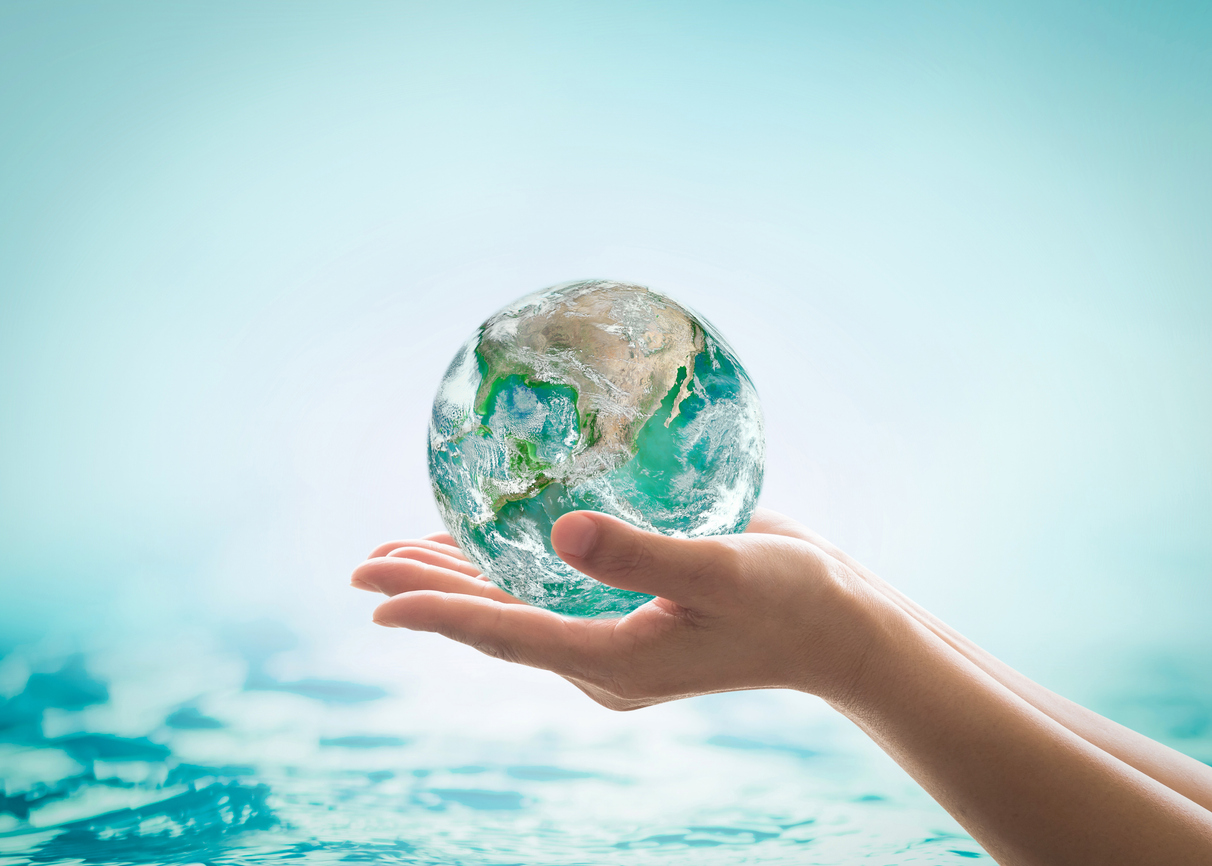
Green Cleaning Practices
Written by Diane Calabrese | Published July 2024

Doing more while using less. Balanced. Green. Good stewards. It’s challenging.
Consider cotton. It seems harmless. Currently cotton is considered a water-guzzling crop. So why not substitute other fabrics for cotton and conserve water? It’s a good idea in the short term. In the long term, cotton substitutes— from bamboo to synthetics—are less durable.
As a result of using less water in the short term, are we using more in the long term? Such fundamental questions must be asked and answered when evaluating what a green practice is or is not.
If less water and minimum-tono chemicals are used to clean, but cleaning must be done more frequently over time, the environment may be more impacted. Balance is everything in nature.
Good stewards determine the point at which the most factors are in balance. In other words, environmental health and societal function (including sanitation, hygiene, and safety) are at a sustainable equilibrium point.
In some parts of the country, homeowners declare their commitment to the environment with signs. A popular sign in this writer’s area begins: “Why this yard looks the way it does…”
Fine, in so far as declaring there has been no mowing and trimming to allow plants to grow as they will. The problem is that the lack of restraint on plants means that privet and pines along the side are stretching across the sidewalk impeding pedestrians (and even poking eyes).
Balance. There can be no balance unless we account for all the positives and negatives.
Some negatives are easier to identify than others. Corrosives, flammables, high VOCs [volatile organic compounds], strong bases and strong acids, and so on are avoided by our industry as a matter of best practice. Any project begins with consideration of the least amount of chemical and least potentially harmful chemical to get it done.
Mike Hilborn, owner of RTD Power Washing in Saint Paul, MN, says that the essential approach for any contractor is the same. “You’ve got to be EPA compliant.”
EPA [Environmental Protection Agency] offers extensive assistance on what’s expected. Professional organizations such as PWNA, UAMCC, and CETA help keep members up to date on regulations and expectations.
“Water reclamation is a must,” says Hilborn. And our industry does a good job with that.
The ideal green practice, of course, would be to recycle and reuse as much water as possible on site when cleaning. And it’s a goal that manufacturers aim to help contractors meet.
As for getting many questions from customers about green practices, environmentally compatible processes, or specific requests, Hilborn says it happens, but it’s not an everyday occurrence. Customers hiring professionals expect them to know what they are doing. Moreover, everyone is still trying to work out just what constitutes green practices—a lack of clarity that can be vexing for everyone.
The situation is similar in the Lone Star State. “We rarely get requests for green products unless it’s from a homeowner,” says Doug Rucker, owner of the Doug Rucker Store in Porter, TX.
“We do get requests from contractors occasionally looking for a product that is safer to use than bleach for organic stains, or strong hydroxide degreasers for oil and grease stain removal,” says Rucker. “Working around koi ponds is another request we get asked about often.”
With experience as both a contractor and a distributor, Rucker knows the complexity of product selection and good outcomes. He offers some products that are specifically designated as green.
“We have been the distributor for the Houston area for the EatOils line of ECOLOGO®-certified green products since 2008,” says Rucker. “The BT200 degreaser for oil, grease, and many other stains and Super Carpet Fresh for organic type stains and odor removal are two products we sell a lot of.”
Because much of the lexicon of green products is still being clarified, we cannot expect customers to have a full understanding. And they don’t. What’s the biggest misunderstanding that customers have about green products? “That just because a product is labeled as ‘green’ does not necessarily mean it is,” says Rucker.
Certifications matter. “For a product to be truly certified as green, there are only a couple of certifications that will do that,” says Rucker. “ECOLOGO®, in my opinion, is the most trusted and reliable certification,” says Rucker. “Biodegradable, sustainable, and other words are used to portray a safe or ‘green’ product, but it does not mean that product is truly certified ‘green.’” [See more about the UL ECOLOGO® certification in the next section.]
WHAT’S GREEN?
A universal definition of “green” products would facilitate conversations and make it possible for everyone to know they are discussing the same thing. For instance, what does a customer mean when he or she asks for a green product?
Linda Chambers is brand and sales manager at GCE/Soap Warehouse Brand in Norcross, GA, and says her company receives many requests from customers who want products designated as green or environmentally friendly. “But they do not understand what ‘green’ even means,” she says.
There are several questions to ask customers. “Do they want it pH neutral, safe enough for their skin?” says Chambers. “Do they just want a product that does not contain hazardous materials?”
Nature Green APC is one example of a green product that Chambers’s company sells. Among its attributes are a neutral pH and no phosphates. It can be used for light industrial cleaning, including emulsifying light grease.
We are back to balance again. Those who want to buy green products must understand the limitations.
“A truly green product with a neutral pH will not be strong enough to clean most stains,” explains Chambers. “Even if you are using a green product, the wastewater created may be hazardous and need to be treated before discharge [because it] is not safe to go down a storm drain.”
Choosing green products does not mean that SDSs [safety data sheets] are out of the picture. “Even a green product with a neutral pH will still contain products that have to be listed as hazardous on an SDS and carry a warning label,” explains Chambers. Safe, safer, safest. That’s the goal when adopting or developing cleaning methods and chemicals.
It’s nice to be able to purchase a product labeled green, yet it’s better to know that there has been some standard applied to the product and designation earned.
The UL ECOLOGO® certification (introduced in the previous section) is such a standard. The certification can be earned by manufacturers and retailers upon evaluation of products across many criteria, which include environmental and health.
There are many types of credentialing bodies that designate products as some variation of green or environmentally friendly. ECOLOGO® considers “overall product sustainability.” The evaluation of a product includes not just its composition but also its packaging, how it was made, and its disposal. It’s impossible to use a cleaning product without releasing some of it into the environment. Consequently, doing the most with the least chemical is an overarching goal of green cleaning. Also include the least water, too, when water is in the mix.
The EPA offers extensive assistance on identification of what it calls “greener cleaning products”— the “greener” being an obvious reminder that all is a work in progress. Manufacturers can apply ecolabels to their products, such as environmentally friendly, eco safe, or green, but such labels are not standardized.
EPA manages both the Safer Choice program and the Design for Environment program. (See EPA.gov.) Safer Choice certifies products with safer ingredients for the environment and health, which are inextricably linked. Design for the Environment is a label specific to antimicrobial products, which include disinfectants and sanitizers.
Concerns about chemicals released during the activities of commerce and industry that sustain societies come in many forms. Chemicals may be released into the air, water, or soil. They may cause irritation (or worse) to exposed skin. They may enter bodies of water, overloading them with nutrients such as phosphorous and nitrogen.
The foregoing is a short list of possible negative consequences attached to chemical use. Potential negatives aside, biodegradable products circumvent unwanted consequences, don’t they? Our readers know they do not. But many consumers read the word “biodegradable” and relax over environmental (and health) concerns.
Speed of degradation is important. Many of the surfactants used in products do biodegrade, but slowly. Slow biodegradation means accumulation.
Green cleaning practices begin long before and extend to well after the activity of a structure, vehicle, or substrate being cleaned. Whether on a jobsite or at a manufacturing facility, there are two common dimensions.
One, the team members handling, using, or developing chemicals follow the safest practices. Two, there is an ongoing commitment to doing the most with the least impact on surroundings.
The EPA offers many aspects to consider when aiming for sustainability. Among the goals are biobased solvents (e.g., citrus, seed, pine oils), low toxicity, low flammability, pH close to neutral, effectiveness in cold water (i.e., energy saver), concentrated formulations, efficient packaging (e.g., including recyclable), nonaerosol application (e.g. pump), and bulk shipping.
It’s all about doing the most with the least—in the short and long term.





